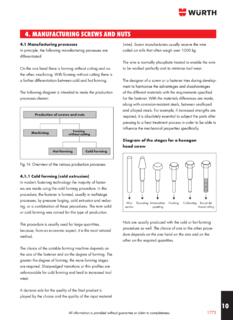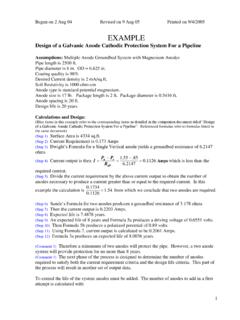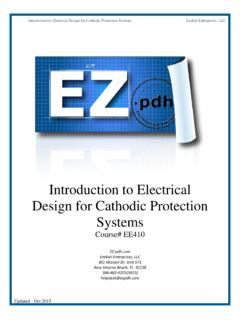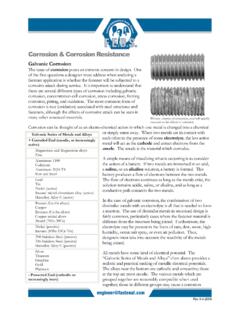Transcription of 5. Surface protection
1 1017775. Surface CorrosionAbout 4% of the gross national product of a western industrial nation is destroyed by 25% of this could be avoided by applying existing is the reaction of a metallic material with its environment that causes a measurable change to the material and may lead to an impairment of the function of a component or of a complete system . This reaction is usually of an electrochemical nature, but in some cases it may also be of a chemical or metal-physical can also observe corrosion in our daily lives:Rust on vehicles, railings and fences Creeping destruction of road structures, bridges, build- ings Leaks in water pipelines and heating pipes made of steelCorrosion is unavoidable but the damage caused by corrosion can be avoided through the correct planning of suitable corrosion protection measures.
2 The corrosion system of a screw assembly should, under operating conditions, be at least as corrosion-resistant as the parts that are to be connected. The design engineer s job is to decide on the necessary corrosion protection measures. Here, the wear reserve of a corrosion protection system and the ambient conditions have to be taken into account. The ways in which corrosion manifests itself can vary greatly. (See DIN 50900 for corrosion types). Corrosion typesSurface corrosion rustCrevice corrosionContact corrosion Electrolyte+All information is provided without guarantee or claim to rates, reference values in m per yearMedium Zincnon-chromatedBrass Ms 63 CopperCuNi SiUnalloyed steel unprotectedCountry air 1 3 4 2 80 Urban air 6 4 2 270 Industrial air6 20 8 4 170 Sea air2 15 6 3 170 Tab.
3 Frequently used types of coatings for Non-metallic coatingsDesignationProcedureApplicationC orrosion resistance Rubbing with oilWorkpieces are immersed in oilBright steel partsSuitable for short-term corrosion protection during transportUndefinedBurnishingWorkpieces are immersed in acid or alkaline layers with a (brown) black colour are created through reactionNo layer developmentPurpose: formation of a weak protective layer on the surfaceNo hydrogen embrittlementParts of weaponsGauges and measuring technologySalt spray test approx. hCorrosion protection oil can increase resistancePhosphatisingSteel component in metal phosphate bath or chamber with metal phosphate solution5 15 m layer connected with the materialIron/manganese/nickel/zinc phosphateCold forming of steelCombination with corrosion protection mediaReduction of wear on manganese phosphatisingPrimer for coat of lacquer (prevents rust creep)Salt spray test: approx.
4 3 hCorrosion protection oil can increase resistanceTab. Metallic coatingsDesignationProcedureApplicationC orrosion resistance Electro-galvanisedMetal deposition in the galvanic bathAfter treatment through passivationOptionally with sealingIn areas with low to average corrosion exposure, general mechanical engineering, electrical engineering system -dependent thermal loadability 80 C 120 CCorrosion resistance to 120 h against backing metal corrosion (red rust) in the salt spray test in accordance with DIN 50021 SS (ISO 9227) (layer thicknesses and dependent on the system ) galvanic zinc alloy layer(zinc-iron)(zinc-nickel)
5 Metal deposition in the galvanic bathAfter treatment through passivationOptionally with sealingIn areas with extreme corrosion exposure components in the engine compartment or on brakes, where normal electro-plating is unable to cope not only because of the great heat but also because of the effect of salt in winterGreatest cathodic corrosion protec-tion even with layer thicknesses from 5 m (important for fits)No voluminous corrosion products with zinc-nickel)Corrosion resistance to 720 h to backing metal corrosion (red rust) in the salt spray test in accordance with DIN 50021 SS (ISO 9227) (layer thicknesses and system -dependent)
6 Electro-nickel platedMetal deposition in the galvanic bathOptionally with impregnation In areas with very low corrosion exposure, decorative applications in interiorsComponent of a multilayer system copper-nickel-chromiumBecause of its electrochemical properties with regard to steel nickel cannot take over the function of a reactive information is provided without guarantee or claim to resistance Electro-chrome platedMetal deposition in the galvanic bathUsually as a coating on a nickel-plated surfaceThickness of the chromium layer usually between m and mIn areas with very low corrosion exposure.
7 Decorative applications in interiorsComponent of a multilayer system copper-nickel-chromiumBecause of its electrochemical properties with regard to steel chromium cannot take over the function of a reactive galvanisedMetal powder is hammered onto the components, glass beads are used as impact material .Coating is carried out by means of a chemical medium, electricity is not is carried out at room washers, high-strength spring-mounted components (no risk of hydrogen induction during the coating process) Corrosion resistance to 144 h against backing metal corrosion (red rust) in the salt spray test in accordance with DIN 50021 SS (ISO 9227) (layer thicknesses and system -dependent)Hot-dip galvanisingImmersion in molten metal bath Min.
8 Layer thicknesses approx. 40 mProcess temperature approx. 450 CGreater corrosion protection Not suitable for small screwsCathodic corrosion protectionFasteners for steel construction. For example, HV kits. Applicable for fasteners M12 Corrosion resistance between 5 and 25 years depending on the environmental conditionsTab. Other coatingsProcedureExplanationsMaximum application temperatureVeralisingSpecial hard coatingBrass coatings are used mainly for decorative purposes. Apart from this, steel parts are coated with brass to improve the adherence of rubber on necessary, as an intermediate layer before nickel-plating, chrome-plating and silver-plating.
9 As a cover layer for decorative coatings are used for decorative and technical is used mainly to achieve or improve soldering capability (soft solder). Serves at the same time as corrosion protection . Thermal after-treatment not protective layer is generated in aluminium through anodic oxidation that works as corrosion protection and prevents staining. Nearly all colour shades can be achieved for decorative zinc-aluminium flake coating, can be produced in extremely different colours. Depending on the layer thickness 500 h or 1000 h in fog test (DIN 50021).Burnishing (blackening) Chemical procedure.
10 Bath temperature approx. 140 C with subsequent oiling. For decorative purposes. Only slight corrosion (stainless)Chemical procedure. The corrosion resistance of A1 A5 can be impaired by this. For decorative purposes. Not suitable for external CPolysealFollowing a conventional immersion procedure a zinc-phosphate layer is applied at first. An organic protective layer is then applied that is precipitation-hardened at approx. 200 C. Following this, a rust- protection oil is applied as well. This protective coating can be carried out in different colours (layer thickness approx. 12 m).ImpregnatingWith nickel-plated parts above all, the micropores can be sealed with wax through after-treatment in dewatering fluid with added wax.







